Bribie
Well-Known Member

Hi guys, Autumn settles over South East Queensland and before getting into the lager brewing season it's time to do an autumn ale, something along the lines of Cameron's Strongarm from Graham Wheeler's book. I'm posting this in one hit as while I'm working you guys are snoring
I use a couple of methods that are gaining popularity in Australia and have been developed here: Brew in a Bag (BIAB) and No-Chill using a plastic cube. More on the No-Chill later.
BIAB:
This is a one vessel system. The full volume of liquor (equivalent to the volume of liquor used in a three vessel brew: i.e. strike liquor plus sparge liquor) is heated to a strike temperature in a vessel lined with a purpose made bag. The grain bill is doughed in and held at mash temperature until 'done'. The bag is then hoisted and drained. The vessel is heated and the wort is boiled with hop additions. From then on fermentation etc proceeds exactly as in any other wort production system.
There are a few ways to do BIAB. In my own case the main equipment is:
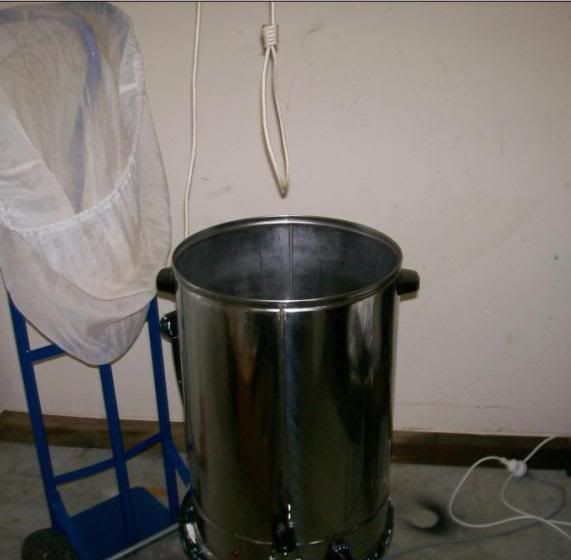
A 40L Electric 2400w stainless steel urn.
A purpose made drawstring bag - a terylene or nylon strong mesh material called Swiss Voile in Australia and available from large material stores. I get mine made by a local âalterations and curtainsâ lady who works from home. A 'skyhook' is handy but not essential
Other paraphernalia includes a sleeping bag, duvet, hop sock, plus all the normal items like mash paddle, thermometers, beer :drink: etc.
The grain bill is prepared
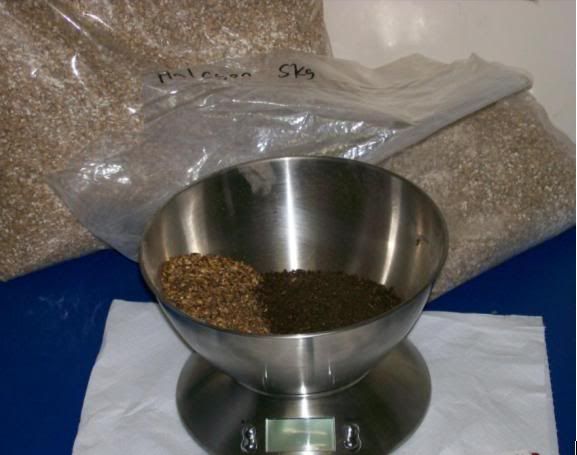
The urn is prepared with around 35L of liquor with salts additions and 3.2 pH buffer and heated to strike temperature.
Strike of 69 degrees will give around a 66 degree mash depending on the size and initial temperature of the grain bill.
The urn is now switched off. My urn has an exposed element and I donât want to melt the bag at that spot.
The bag is fitted and the grain bill doughed in.
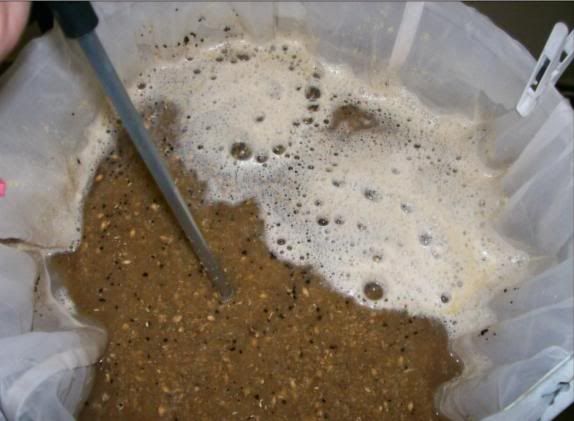
After a temp. check (I hit 66 spot on here) the urn is lidded then passively lagged by slipping a sleeping bag over it and the whole thing is wrapped in a cheap Chinese (of course)
I walk away for 90 minutes, I would normally get around a 2 degree drop.
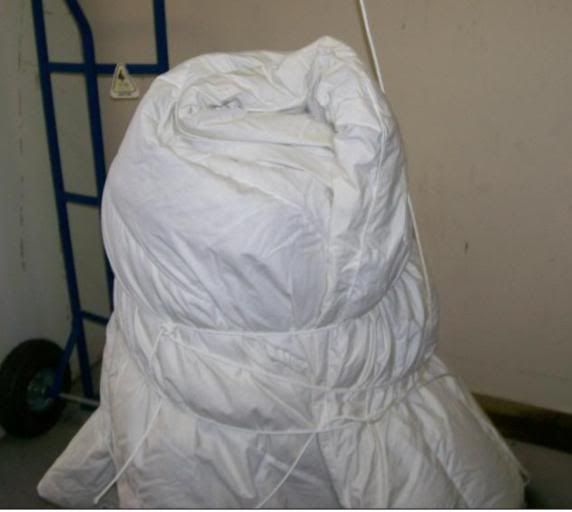
The bag is hoisted and the urn switched on to begin heating to a rolling boil.
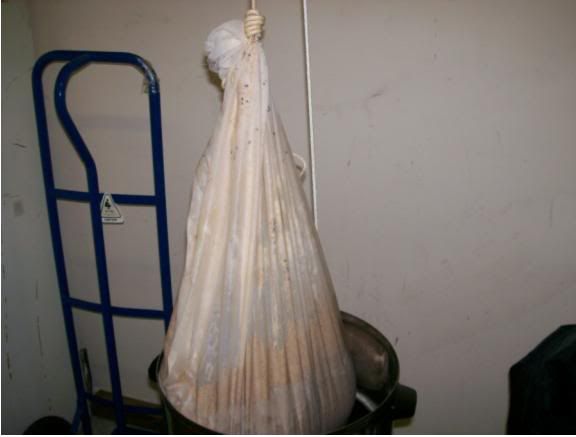
After a good squeeze the bag is removed and a hopsock suspended, with initial hop addition.
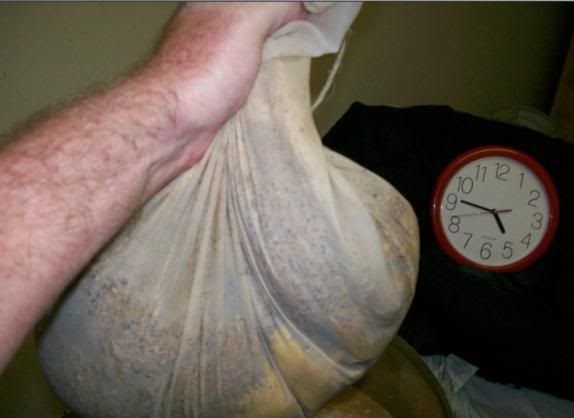
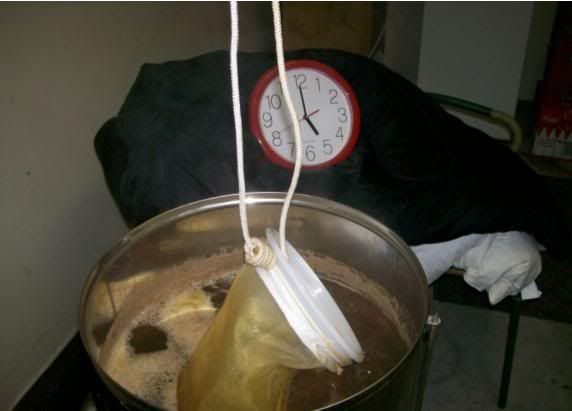
Rolling boil for at least 90 mins and later hop additions if required.
Whirlfloc is added and at end of boil, the hop sock is hoisted and drained, the urn switched off and the trub allowed to settle.
To recap: The entire volume of liquor is prepared and heated âup frontâ. The BIAB vessel starts as the HLT, becomes the mash tun, and finally the kettle. A lot of BIABers use a large pot and gas burner but the system is the same. The end result is a wort, just like the 3 vessel system and from there things proceed as ânormalâ.
In case you are wondering, there are certainly a few âtweaksâ that can be done to improve efficiency; for example in my case I do a sort of mashout by drawing a few litres of first runnings out of the urn into a stockpot then I pour an equal amount of boiling water into the urn, do a vigorous stir, hoist and drain the bag then pour the first runnings back in and just do a longer boil to get the volume back to what it would have been⦠BIAB is still a work in progress with an enthusiastic community trying new tweaks all the time ⦠but even in its basic form it is a quick and easy way to get into all - grain.
Disadvantages are that it is not scaleable, it is effectively limited to ânormalâ size batches, and it is best suited to mainstream strength brews; once you get much over 5.5% ABV you run into efficiency problems. Bag hoisting and squeezing gets you up close and personal with hot wort and there are some safety issues that must always be kept in mind. However within its limitations BIAB works very well indeed.
As a further note yes, I know that Bruheat type boilers are popular in the UK and I owned one for many years when I lived in Cardiff. Great bit of kit but only about 25 litres. Here we are talking about a vessel that can take the entire liquor requirement and needs to be at least 40 litres. Pot and gas BIABers here often opt for sixty litres to give them more leeway.
Now the choice is: how to cool the wort?
No-Chill
In the last few years an alternative to counterflow chillers, plate chillers etc has become popular with many home brewers in Australia, known generally as âNo-chillâ. Of course many three vessel brewers use No-Chill and many BIAB brewers use counter flow chillers. I just happen to use BIAB and No-chill personally.
The hot wort is carefully drawn off the trub into a well sanitised plastic food grade âcubeâ of the sort used to carry water. The cube is sealed then allowed to cool in its own good time. Popular sizes are 20 L and 25 L available from large hardware and camping stores and must be sturdy food grade high density polyethylene HDPE. The nominally 20L size actually can fit up to 23 L which makes it ideal for a âstandardâ brew. A skinny jerrycan shape as in the photo is good because of the surface to volume ratio that allows quicker cooling.
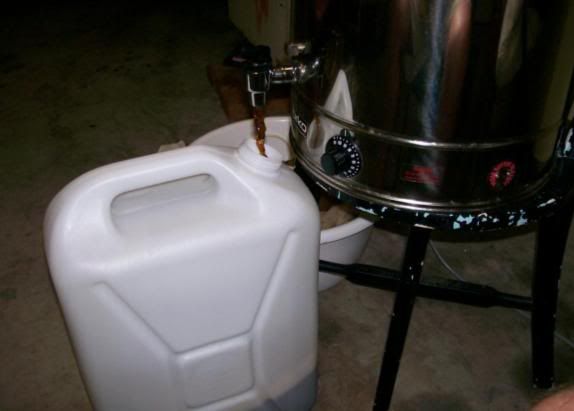
The two essentials in No-chill are thorough sanitisation and as far as possible the elimination of any head space in the cube. The hot wort further pasteurizes the container.
This method actually has a bit in common with jam and preserve making in that the cubed wort can keep for long periods and can be poured into the fermenter and pitched when convenient. I have kept worts from January till April and have heard of brewers keeping a cubed wort for up to a year. Here, No-Chill has advanced from being a somewhat experimental and controversial method to becoming quite âmainstreamâ and regarded as dead reliable.
Advantages:
It saves on the cost of a chiller.
It âdecouplesâ the wort production from the need to pitch ASAP.
So it enables worts to be produced ahead of time. If you have a heap of free time to devote to brewing â for example on annual leave â can have a brew blitz and build up stocks to be fermented over the coming months when you may be more âtime poorâ.
It is a flexible method that enables the running of sociable brew days; recently the Brisbane Amateur Beer Brewers Club held a brew day at the invitation of a local commercial craft brewery and at the end of the day 25 members took home a cube each of brewery produced wort to brew at home. Some brewers do âwort swapâ brew days.
Disadvantages:
Possibility of DMS (sweet corn, cabbage) taint in the enclosed hot wort (I believe this may be an issue with some USA malts)
Because the wort remains at above 80 degrees for a longer period there is some debate that alpha acid isomerisation continues with the flavouring and aroma hops leading to unwanted bitterness. Some No chillers adjust recipes and hop times accordingly or do late additions into the fermenter.
Some brewers have reported a decrease in hop aroma with some beer styles compared to quick-chilling but again this can be compensated for with late hopping during fermentation.
Personally I would recommend this as a brilliant way to cool wort in the UK especially in cooler areas and times of the year.
I hope this has given you some food for thought, anyway time for a couple more pints !! :

Cheers
Michael (Yorkshire Geordie crossbreed)
Queensland




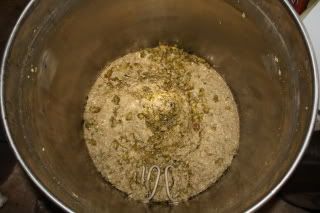














![BREWING THERMOMETER STICKERS ACCURATELY MONITOR FERMENTING BEER & WINE LIQUID TEMPERATURES 5PCS HOME BREW SPIRITS WINE LCD ADHESIVE [US]](https://m.media-amazon.com/images/I/311DDjo2X3L._SL500_.jpg)





















